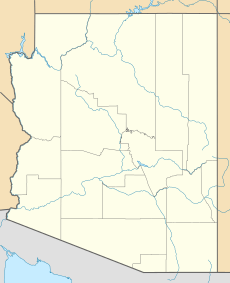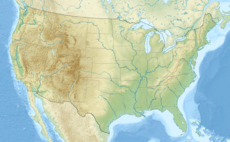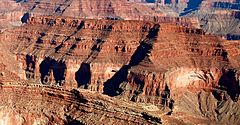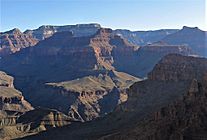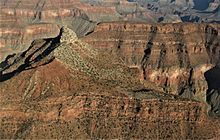Horus Temple facts for kids
Quick facts for kids Horus Temple |
|
|---|---|
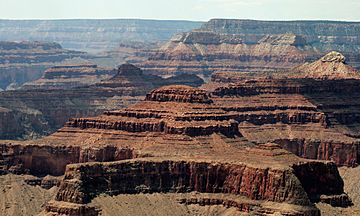
Tower of Set prominence (center)
Horus Temple prominence (upper right), with white-Coconino Sandstone capstone, on eroded slopes of Hermit Formation |
|
| Highest point | |
| Elevation | 6,150 ft (1,870 m) |
| Prominence | 610 ft (190 m) |
| Isolation | 0.73 mi (1.17 km) |
| Parent peak | Osiris Temple |
| Naming | |
| Etymology | Horus |
| Geography | |
| Location | Grand Canyon Coconino County, Arizona, US |
| Parent range | Kaibab Plateau Colorado Plateau |
| Geology | |
| Type of rock | (caprock-debris cliff)-Coconino Sandstone, on slopes of Hermit Formation (shale) debris, upon platform of resistant cliff-former Esplanade Sandstone and Coconino Sandstone-caprock, Hermit Formation, Esplanade Sandstone-platform-(Supai Group, unit 4 of 4), Supai Group, Redwall Limestone, Muav Limestone, Bright Angel Shale, Tapeats Sandstone |
Horus Temple is a mountain peak that stands 6,150 feet (about 1,875 meters) tall. It is located in the amazing Grand Canyon in Arizona, USA. This peak is a type of mountain called a butte, which means it has very steep sides and a flat top. Horus Temple is the middle peak in a line of three mountains, found southwest of the Shiva Temple.
Layers of Rock: The Geology of Horus Temple
Horus Temple is made up of many different layers of rock, like a giant cake! These layers tell us about Earth's history.
The Top Layers
The very top of Horus Temple is a flat area that stretches from north to south. This flat top is made of reddish rocks from a group called the Supai Group. These rocks formed a very long time ago, during periods known as the Pennsylvanian and Permian.
The highest and strongest part of the Supai Group is a tough rock called the Esplanade Sandstone. This sandstone is very hard and helps form the flat top.
At the northern end of the flat top, you'll see the main peak of Horus Temple. This peak is a broken piece of Coconino Sandstone. This sandstone forms cliffs and acts like a "capstone" or a hard hat on top of the mountain. Below this capstone, there's a small slope made of a deep brown-red rock called the Hermit Formation. This rock tends to form slopes rather than steep cliffs.
Lower Rock Formations
Below the Supai Group, you'll find another strong rock layer called the Redwall Limestone. This limestone is also very hard and forms tall cliffs, just like in the nearby Tower of Set to the south.
Underneath the Redwall Limestone, there's a shorter but still strong cliff made of Muav Limestone.
Even deeper, you'll find two more rock layers that are part of the Tonto Group. The first is the Bright Angel Shale, which has a dull greenish color. The second is the Tapeats Sandstone, which is a deep brown. These different colors and types of rock make the Grand Canyon so beautiful and unique!
Gallery


